Executive Summary
Growth in the Swiss economy strengthened in Q3, up 2.5 percent on an annualized basis. While GDP growth in Switzerland has been more muted over the past few quarters, today’s print affirms broad-based growth in both domestic and external demand. Amid solid economic growth, Switzerland has faced low inflation over the past several years, pushing the Swiss National Bank (SNB) to move its policy rate into negative territory and actively manage its exchange rate to avoid additional deflationary pressures from a strengthening Swiss franc. The SNB’s easing policies have contributed to growth in bank lending that pushed up levels of household debt. However, today’s GDP print points to positive economic growth that will likely push inflation slowly higher over time and allow the SNB to gradually reverse its accommodative stance. Higher future interest rates could weigh on leveraged Swiss households by increasing debt-servicing costs, but, in the near term, inflation still has room for significant improvement before the SNB will likely move to raise rates.
Broad-Based GDP Growth Registered in the Third Quarter
Data released today showed that real GDP in Switzerland grew 0.6 percent (2.5 percent annualized) on a sequential basis in Q3-2017 (Figure 1). Today’s print affirms broad-based strength in domestic demand across multiple sectors of the Swiss economy. Investment spending was solid for equipment and software products, up 2.9 percent on a year-ago basis. A drawdown in inventories in the third quarter supports strength in the private sector and is promising for future expansion, as firms will likely need to rebuild inventory stock in the coming quarters. Swiss consumers also saw solid economic growth in the third quarter. Household consumption was up 0.4 percent on a sequential basis (1.2 percent year over year), likely boosted by solid employment growth as the unemployment rate has edged lower in recent months (Figure 2).
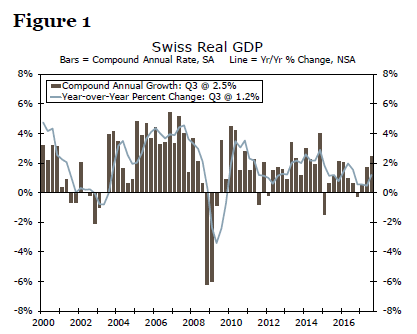
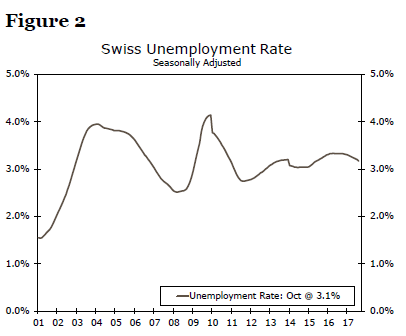
Switzerland also enjoyed a pickup in external demand in Q3 that was additive to topline GDP growth. Swiss exports were particularly strong, with exports of goods up 2.1 percent for the quarter after the slower 0.7 percent rate of growth registered in Q2. Stronger export growth is consistent with the pickup in global demand seen more broadly and reaffirms the broad-based economic growth in the quarter, especially as the private sector continues to expand to meet global demand. Imports saw a retrenchment in Q3, with both imports of goods and services declining over the quarter. However, after particularly strong growth in imports in Q2 and solid consumer and business demand in Q3, we should see imports bounce back in the future. While we do not forecast Swiss GDP explicitly, the consensus expects solid economic growth to continue in the coming quarters, with GDP growth forecasted to be between 1.5 percent and 2.0 percent in 2018, likely supported by solid domestic and external demand.
Mild Deflation = Extraordinary Monetary Accommodation
The Swiss economy has been more or less expanding for eight consecutive years, but inflation in Switzerland remains essentially non-existent. The economy experienced mild deflation in 2012- 2013 and again in 2015-2016, which has brought the consumer price index at present nearly 3 percent below the level that prevailed in mid-2011. Inflation has returned to positive territory in recent months, but the overall and core rates both remain well below 1 percent (Figure 3). As CPI inflation weakened and then turned negative, the SNB cut its target rate for 3-month Swiss LIBOR, its main policy rate, to zero percent and then eventually to -0.75 percent, where it remains today (Figure 4).
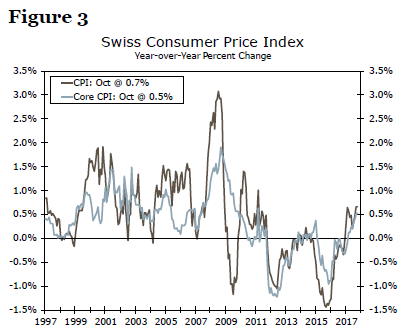
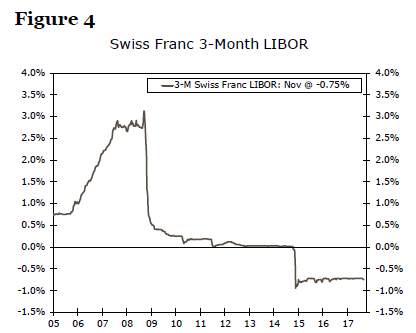
In addition, the SNB turned to exchange rate policy to try and combat the deflationary forces that were buffeting the economy. Imports of goods and services are equivalent to about 50 percent of nominal GDP, and the sharp appreciation of Swiss franc between early 2008 and mid-2011 – it strengthened more than 40 percent on a trade-weighted basis – contributed to the deflationary pressures in Switzerland. Consequently, the SNB announced in September 2011 that it would no longer tolerate an exchange rate stronger than 0.83 euros per Swiss franc (Figure 5). To prevent the exchange rate from strengthening beyond this line in the sand, the SNB had to buy euros and sell Swiss francs in the foreign exchange (FX) market.1 The SNB’s buying of euros and selling of its own currency led to a sharp increase in its FX reserves and a corresponding rise in the growth rate of the Swiss money supply (Figure 6).
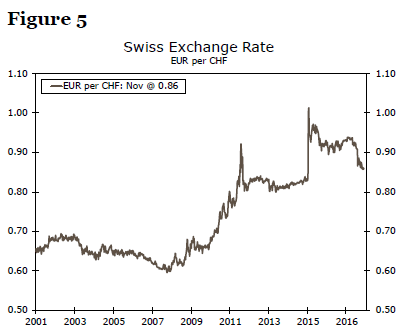
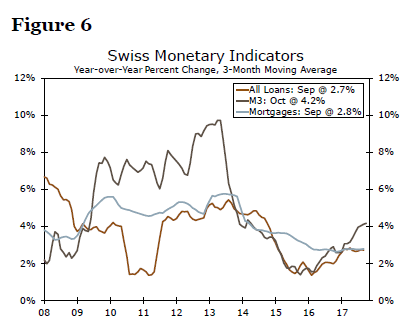
The Challenges for the SNB Going Forward
These easing steps by the SNB likely prevented deflation from becoming even worse. However, the policy steps may have had some side effects that could potentially prove to be a bit problematic. Specifically, low interest rates and ample bank liquidity fueled solid growth in bank lending, especially in mortgages. The ready availability of mortgage financing helped to push up home prices, which have risen about 25 percent on a nationwide basis since 2010. House prices in some of the country’s more densely populated cities such as Zurich and Geneva rose even more, although they are now starting to edge lower.
Despite the deceleration in mortgage lending over the past few years, the debt-to-GDP ratio of the Swiss household sector has continued to trend higher and is closing in on 130 percent (Figure 7), which gives Switzerland one of the highest ratios among advanced economies. Although mortgage lending in Switzerland has grown only 3 percent or so per annum over the past few years, nominal income growth in the economy has been anemic during that period due to the deflationary forces that have taken hold. Fortunately, the low level of interest rates in Switzerland has kept the debt service ratio (DSR) of the private sector contained (Figure 8).
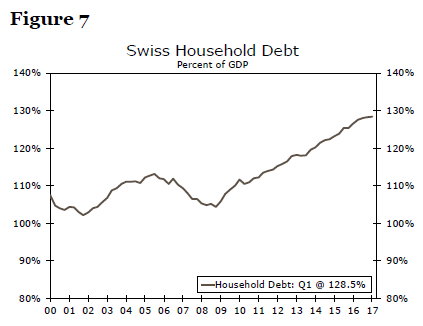
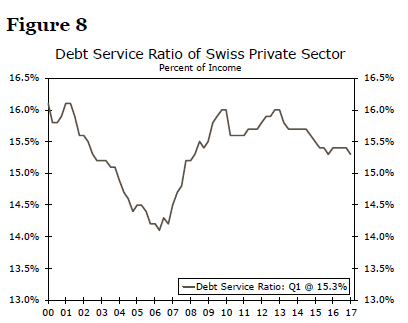
As Figure 8 makes clear, the DSR rose markedly between 2006 and 2009 when the SNB was hiking rates. With the household debt-to-GDP ratio about 25 percentage points higher than it was when the SNB commenced its last tightening cycle, the DSR has potential to move up significantly. That said, the SNB is not likely to hike rates anytime soon. However, if the economy strengthens further in the coming year, as is widely expected, the CPI inflation rate likely will trend higher, if only slowly. Sooner or later the SNB will begin to tighten monetary policy, which could eventually lead to a noticeable rise in debt-servicing costs for households as mortgage rates reset. Higher debt-servicing costs for households could then weigh on growth in consumer spending.
Conclusion
Solid economic growth in Switzerland in Q3 has likely put the economy on track to tackle the challenges of lackluster inflation and an upward trend in household debt seen over the past few years. While the SNB will likely need to see significant improvement in inflation before beginning to hike rates, in our view CPI inflation will likely trend slowly higher. Today’s positive GDP print and solid domestic demand will likely support a gradual acceleration in prices, allowing the SNB to reverse its accommodative stance at a gradual pace. Slowly increasing inflation could exert upward pressure on wage growth, potentially counteracting higher debt-service costs as the SNB eventually begins to raise rates. In the near term, the consensus expects the broad-based strength in the Swiss economy to continue in the coming quarters.













